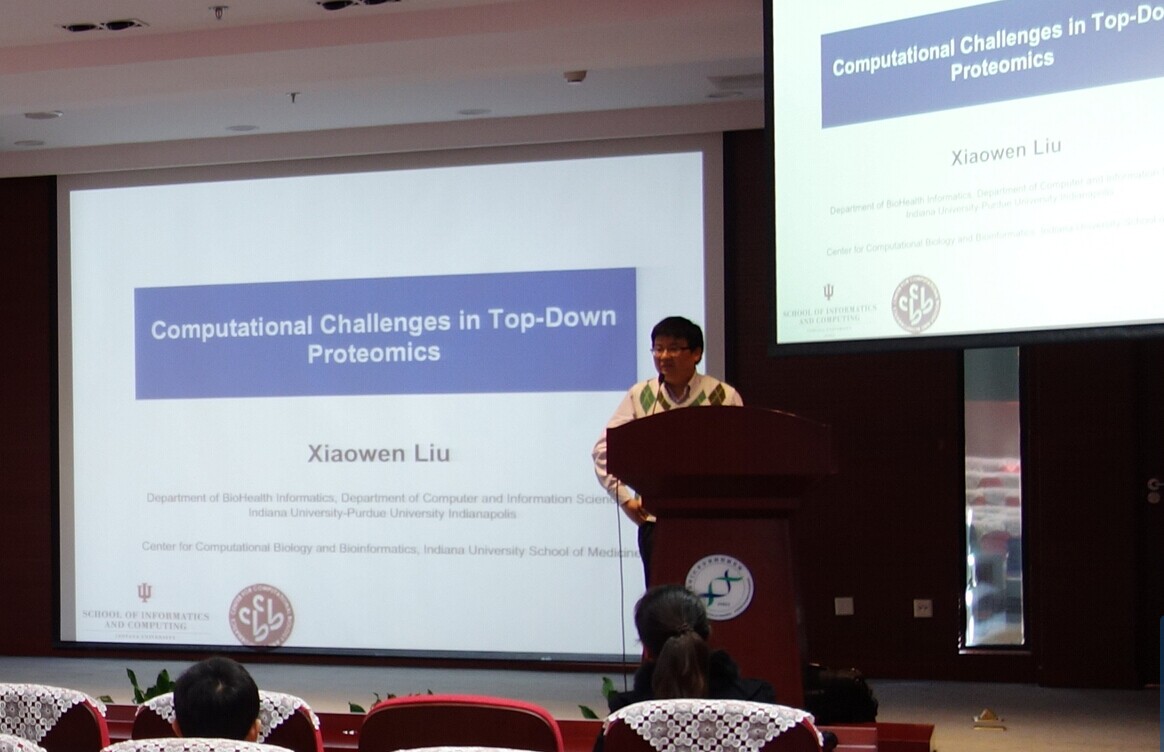Bottom-up proteomic technique has ruled proteomics and metabolome studies for decades. It requires a digestion process that breaks proteins into short peptides and later searches the tandem mass spectra of the peptides against a protein database. This approach results in broad proteome coverage, but some key information might lose during the digestion, such as combinatorial patterns of post-translational modifications (PTMs). With the rising focus on PTMs, top-down proteomics was born to the challenges. Without the digestion step, top-down proteomics directly maps tandem mass spectra to intact proteins, reserving the necessary information of PTM patterns and making it possible to understand complex proteoforms. On November 13th, Dr. Xiaowen Liu from Indiana University-Purdue University, Indianapolis gave a seminar on “Computational Challenges in Top-Down Proteomics” at the Beijing Institute of Genomics (BIG), Chinese Academy of Sciences. He introduced recent developments in top-down proteomics and new problems posed by the fast developing techniques: identification of multiple PTMs in a protein, speed-up of top-down spectral analysis, and accurate estimation of statistical significance of identifications. Dr. Liu presented the tool MS-Deconv for top-down spectral deconvolution, which generates a large set of candidate isotopomer envelopes for a spectrum and uses a graph-based algorithm to select envelopes that explain the spectrum well. The software tool MS-Align+ were developed to identify proteins with novel PTMs. He further developed a pipeline for de novo protein sequencing by combining the top-down and bottom-up tandem mass spectra, which improves the sequence coverage and accuracy. Dr. Liu actively interacted with students and faculty members of the BIG throughout the seminar. The methodology used in Dr. Liu’s lab includes many frontier techniques in proteomics and novel algorithms for proteomic data analysis. He generously offered trial opportunities to the interested audience. Dr. Liu is an Assistant Professor at Indiana University-Purdue University, Indianapolis (Homepage: http://mypage.iu.edu/~xwliu/). His research focuses on the fast developing proteomics techniques and proteomic data analysis. Dr. Liu joined the GPB editorial board in 2013 and helped with article quality of GPB by being actively involved in handling review processes and inviting submissions as other board members do, especially in the area of proteomics. Dr. Liu was invited to give a talk by the Outstanding Scientists Forum program of the journal Genomics, Proteomics and Bioinformatics (GPB). GPB is a peer-reviewed journal that publishes papers from all over the world in the fields of omics and bioinformatics. GPB aim to serve as a premier platform for communication among scientists in omics and bioinformatics field, and enhance collaborations among scientific communities. More details about the journal can be found at http://www.journals.elsevier.com/genomics-proteomics-and-bioinformatics. If you’re interested in giving talks in Beijing Institute of Genomics, CAS and exploring opportunities of collaboration with the top biological and bioinformatics scientists in China, please feel free to contact our editorial office (editor@big.ac.cn). For students and faculty members who are interested in inviting top scientists around the world to our institute, we would also welcome your suggestions and help. Abstract for Dr. Xiaowen Liu’s talk: While the genome provides the blueprint of gene products, proteins are the bricks and mortar of biology. Mass spectrometry (MS) is the core technology for the study of proteins, their post-translational modifications, and their interactions. Over the past decade, proteomics has been dominated by bottom-up MS that digests proteins into fragments and analyzes the resulting short peptides. Since information about intact proteins is lost during digestion, recent studies advocated top-down MS that analyzes intact proteins and gives rise to many computational challenges. While top-down MS researchers have made great progress, the algorithms for interpreting top-down MS data are still in their infancy. We describe computational challenges and combinatorial algorithms for the analysis of top-down MS data and show how they enable new biological applications. Dr. Liu was giving a talk (Image by GPB)
